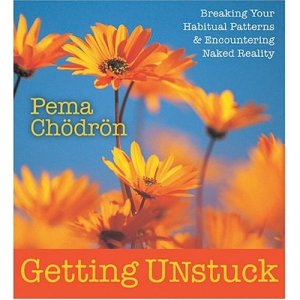Last week, I wrote about Wallace Stevens’s poem “The Snow Man”, arguing that Stevens was writing about shunyata. My real and abiding fascination with this kind of investigation is looking at representation of the Buddhist view—emptiness, interconnectedness, mindfulness, etc.—as they appear in Western culture. The idea is to recognize how Buddhist ways of thinking and perceiving the world have been successfully translated into Western art, fiction, movies, poetry, music, etc.. This is where it’s at for me. I love traditional forms of study—retreats, books, slogans, actual freaking at-home and at-Shambhala or at-I.D.P. (or wherever) regular meditation practice—but what is most important for me in this lifetime is learning how to express these values we Buddhists have come to embrace—especially basic mindfulness—in a way that dynamically captures the public consciousness. I am dedicated to finding ways to share the Buddhist teachings using standard, everyday English and popular, universal forms.
So, while I am eager to focus on my next subject, the great Dale Cooper, F.B.I. agent on the case of Laura Palmer, in David Lynch’s cult classic “Twin Peaks”, I want to use this post to merely open up the brainstorming floodgates. I’d love to hear from you about your favorite representations of Buddhist thought or of an actual Buddhist character in Western culture. Next week, I promise a more detailed critical analysis of the great Dale Cooper. But for now, here are a few other actual representations of Buddhism in Western culture that first come to mind for me:
a. F.B.I. Agent Dale Cooper; “Twin Peaks”, by David Lynch and Mark Frost, played by Kyle MacLachlan, 1990
b. Teddy McArdle; “Teddy”, by J.D. Salinger, 1953 (Vedic)
c. Ray Smith; “The Dharma Bums”, by Jack Kerouac, 1958
d. Maude; “Harold and Maude”; by Colin Higgins, directed by Hal Ashby, played by Ruth Gordon, 1971
e. Mike Mahoney Lobsang Dhargey; “The Lay of the Land”, by Richard Ford, 2006
Looking at these five representations, I’ve begun to develop the following working thesis: the trajectory of these five characters, representing, to a certain degree, the integration of Buddhism into western culture, shows a gradual assimilation of the Buddhist individual deeper and deeper to western society.
What other examples come to mind for you? Which examples have you found particularly successful? Particularly unsuccessful (or not helpful)? To what degree is the popular cultural understanding of Buddhism or Buddhist values relevant to how you think about your faith?

